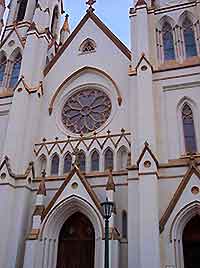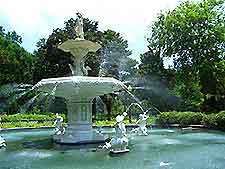Savannah History Facts and Timeline
(Savannah, Georgia - GA, USA)

In spite of its often violent past, Savannah, Georgia has a fascinating heritage and history laid out downtown in its Historic District, Victorian Historic District and some 22 'green and pleasant squares'. After several hundred years of settlement by Native Americans, the original British colonial town of Savannah was born when Colonel James Oglethorpe landed with his 144 settlers at Yamacraw Bluff in 1733.
After being greeted by tribespeople and Indian trader John Musgrove and his wife, Mary, Oglethorpe christened the settlement on that day. By 1751, Georgia had been named a Royal Colony with the town, named for its river and designated its colonial capital.
The Early Years
The climate of Savannah, America's first planned city using a grid system, was perfect for cotton plantations, with the colony's cotton production being the earliest export commodity, along with silk to a lesser extent. Within 30 years of the first settlers' arrival, a ton of silk and many tons of cotton were being shipped from the town's port to England every year, bringing riches and prosperity to the region, primarily through the use of African slaves. This practice was made legal in the state in 1749 by the repeal of a previous act brought in by James Oglethorpe.
The War of Independence
By April 1764, relations between the New World colonies and the British government were becoming strained, with the first serious dispute prompted by Parliament's passing of the Sugar Act. By 1775, the American War of Independence was inevitable and by 1778, British troops were in control of Savannah, having agreed not to ransack the town if they were allowed entry.
The British remained until 1782, and the city flourished after independence was won by the former colonies in 1783, although slavery was signed into legality to boost the cotton plantations, thus continuing a dark part of Savannah history.
Fame and the American Civil War
With its port and economy booming through cotton, Savannah's new-found wealth created lavish mansions and civil buildings across the city. The still-standing Savannah Cotton Exchange set world commodity prices on many occasions, and the damage caused by two devastating fires in 1796 and 1820 was repaired promptly on each occasion.
Previous to the American Civil War, Savannah was famous for its picturesque cityscape and serene lifestyle. Its charm saved the city from total destruction by General Sherman's Union army in 1864, since Sherman couldn't bring himself to issue the order to burn it to the ground as he had done with
Atlanta. Instead, he offered the city to US President Lincoln as a Christmas gift.

Reconstruction
In the reconstruction period following the American Civil War, Savannah's economy collapsed and food was in short supply, although the freed slaves soon established thriving self-help communities based around their churches and schools. By the early 20th century, the cotton industry had revived and was joined by resin and lumber as a source of revenue, until a plague of boll weevils struck, destroying the cotton plants. This happened concurrently with the Great Depression and its subsequent bank and business failures.
The Last 60 Years
The city's struggles to re-establish itself began to bear fruit in the 1950s, with a push by concerned female citizens to restore its heritage heart rather than sending in the bulldozers.
With the establishment of the Historic Savannah Foundation, the downtown's beautiful architecture, including its impressive churches, mansions and the Pirate's House Inn - mentioned in Robert Louis Stevenson's Treasure Island, were saved and have now drawn over 50 million visitors to the city since the start of the new millennium. This district is now one of America's largest National Historic Landmarks, with Savannah history and heritage on magnificent display.
 In spite of its often violent past, Savannah, Georgia has a fascinating heritage and history laid out downtown in its Historic District, Victorian Historic District and some 22 'green and pleasant squares'. After several hundred years of settlement by Native Americans, the original British colonial town of Savannah was born when Colonel James Oglethorpe landed with his 144 settlers at Yamacraw Bluff in 1733.
In spite of its often violent past, Savannah, Georgia has a fascinating heritage and history laid out downtown in its Historic District, Victorian Historic District and some 22 'green and pleasant squares'. After several hundred years of settlement by Native Americans, the original British colonial town of Savannah was born when Colonel James Oglethorpe landed with his 144 settlers at Yamacraw Bluff in 1733.